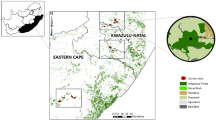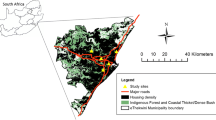Abstract
Disentangling the confounded effects of edge and area in fragmented landscapes is a recurrent challenge for landscape ecologists, requiring the use of appropriate study designs. Here, we examined the effects of forest fragment area and plot location at forest edges versus interiors on native and exotic bird assemblages on Banks Peninsula (South Island, New Zealand). We also experimentally measured with plasticine models how forest fragment area and edge versus interior location influenced the intensity of avian insectivory. Bird assemblages were sampled by conducting 15 min point-counts at paired edge and interior plots in 13 forest fragments of increasing size (0.5–141 ha). Avian insectivory was measured as the rate of insectivorous bird attacks on plasticine models mimicking larvae of a native polyphagous moth. We found significant effects of edge, but not of forest patch area, on species richness, abundance and composition of bird assemblages. Exotic birds were more abundant at forest edges, while neither edge nor area effects were noticeable for native bird richness and abundance. Model predation rates increased with forest fragmentation, both because of higher insectivory in smaller forest patches and at forest edges. Avian predation significantly increased with insectivorous bird richness and foraging bird abundance. We suggest that the coexistence of native and exotic birds in New Zealand mosaic landscapes enhances functional diversity and trait complementation within predatory bird assemblages. This coexistence results in increased avian insectivory in small forest fragments through additive edge and area effects.





Similar content being viewed by others
References
Anderson L, Burgin S (2008) Patterns of bird predation on reptiles in small woodland remnant edges in Peri-Urban North-Western Sydney, Australia. Landscape Ecol 23:1039–1047
Anderson SH, Kelly D, Ladley JJ, Molloy S, Terry J (2011) Cascading effects of bird functional extinction reduce pollination and plant density. Science 331:1068–1071
Banks-Leite C, Ewers RM, Metzger JP (2010) Edge effects as the principal cause of area effects on birds in fragmented secondary forest. Oikos 119:918–926
Barbaro L, van Halder I (2009) Linking bird, carabid beetle and butterfly life-history traits to habitat fragmentation in mosaic landscapes. Ecography 32:321–333
Barber NA, Marquis RJ (2011) Light environment and the impacts of foliage quality on herbivorous insect attack and bird predation. Oecologia 166:401–409
Bates D, Maechler M, Bolker B (2011) lme4: linear mixed-effects models using S4 classes. R package version 0.999375-39
Berndt LA, Brockerhoff EG, Jactel H, Weis T, Beaton J (2004) Biology and rearing of Pseudocoremia suavis, an endemic looper (Lepidoptera: Geometridae) with a history of outbreaks on exotic conifers. N Z Entomol 27:73–82
Brand LA, George TL (2001) Response of passerine birds to forest edge in coast redwood forest fragments. Auk 118:678–686
Bretagnolle V, Gillis H (2010) Predator–prey interactions and climate change. In: Moller AP, Fiedler W, Berthold P (eds) Effects of climate change on birds. Oxford University Press, New York, pp 227–248
Brockerhoff EG, Barratt BIP, Beggs JR, Fagan LL, Kay MK, Phillips CB, Vink CJ (2010) Impacts of exotic invertebrates on New Zealand’s indigenous species and ecosystems. N Z J Ecol 34:158–174
Brotons L, Herrando S (2003) Effect of increased food abundance near forest edges on flocking patterns of coal tit Parus ater winter groups in mountain coniferous forests. Bird Study 50:106–111
Burns BR, Floyd CG, Smale MC, Arnold GC (2011) Effects of forest fragment management on vegetation condition and maintenance of canopy composition in a New Zealand pastoral landscape. Austral Ecol 36:153–166
Cassey P (2001) Determining variation in the success of New Zealand land birds. Global Ecol Biogeogr 10:161–172
Clout MN, Gaze PD (1984) Effects of plantation forestry on birds in New Zealand. J Appl Ecol 21:795–815
Clout MN, Hay JR (1989) The importance of birds as browsers, pollinators and seed dispersers in New Zealand forests. N Z J Ecol 12:27–33
Deconchat M, Brockerhoff EG, Barbaro L (2009) Effects of surrounding landscape composition on the conservation value of native and exotic habitats for native forest birds. Forest Ecol Manag 258:S196–S204
Ewers RM, Didham RK (2006) Confounding factors in the detection of species responses to habitat fragmentation. Biol Rev 81:117–142
Ewers RM, Thorpe S, Didham RK (2007) Synergistic interactions between edge and area effects in a heavily fragmented landscape. Ecology 88:96–106
Fletcher RJ, Ries L, Battin J, Chalfoun AD (2007) The role of habitat area and edge in fragmented landscapes: definitively distinct or inevitably intertwined? Can J Zool 85:1017–1030
Giffard B, Corcket E, Barbaro L, Jactel H (2012) Bird predation enhances tree seedling resistance to insect herbivores in contrasting forest habitats. Oecologia 168:415–424
González-Gómez PL, Estades CF, Simonetti JA (2006) Strengthened insectivory in a temperate fragmented forest. Oecologia 148:137–143
Harper KA, Macdonald SE, Burton PJ, Chen JQ, Brosofske KD, Saunders SC, Euskirchen ES, Roberts D, Jaiteh MS, Esseen PA (2005) Edge influence on forest structure and composition in fragmented landscapes. Conserv Biol 19:768–782
Haslem A, Bennett AF (2011) Countryside vegetation provides supplementary habitat at the landscape scale for woodland birds in farm mosaics. Biodivers Conserv 20:2225–2242
Herrera JM, Garcia D, Morales JM (2011) Matrix effects on plant-frugivore and plant-predator interactions in forest fragments. Landscape Ecol 26:125–135
Higgins PJ, Peter JM, Cowling SJ (2006) Handbook of Australian, New Zealand and Antarctic Birds, vol 7: Boatbill to Starlings. Oxford University Press, Melbourne
Holdaway RN (1989) New Zealand’s pre-human avifauna and its vulnerability. N Z J Ecol 12:11–25
Koh LP, Menge DNL (2006) Rapid assessment of Lepidoptera predation rates in neotropical forest fragments. Biotropica 38:132–134
Laurance WF (2002) Hyperdynamism in fragmented habitats. J Veg Sci 13:595–602
Loiselle BA, Farji-Brenner AG (2002) What’s up? An experimental comparison of predation levels between canopy and understory in a tropical wet forest. Biotropica 34:327–330
MacLeod CJ, Till A (2007) Crop use by introduced bird species in winter in relation to crop structure and seed resources. Bird Study 54:80–86
MacLeod CJ, Newson SE, Blackwell G, Duncan RP (2009) Enhanced niche opportunities: can they explain the success of New Zealand’s introduced bird species? Divers Distrib 15:41–49
Maitner BS, Rudgers JA, Dunham AE, Whitney KD (2012) Patterns of bird invasion are consistent with environmental filtering. Ecography 35:614–623
Mäntylä E, Klemola T, Sirkiä P, Laaksonen T (2008a) Low light reflectance may explain the attraction of birds to defoliated trees. Behav Ecol 19:325–330
Mäntylä E, Alessio GA, Blande JD, Heijari J, Holopainen JK, Laaksonen T, Piirtola P, Klemola T (2008b) From plants to birds: higher avian predation rates in trees responding to insect herbivory. PLoS ONE 3:e2832
Mazerolle MJ (2011) AICcmodavg: model selection and multimodel inference based on (Q)AIC(c). R package version 1.15
Mols CMM, Visser ME (2002) Great tits can reduce caterpillar damage in apple orchards. J Appl Ecol 39:888–899
Murphy DJ, Kelly D (2003) Seasonal variation in the honeydew, invertebrate, fruit and nectar resource for bellbirds in a New Zealand mountain beech forest. N Z J Ecol 27:11–23
Oksanen J (2011) Multivariate analysis of ecological communities in R: vegan tutorial. R package version 2.0-1
Parker TH, Stansberry BM, Becker CD, Gipson PS (2005) Edge and area effects on the occurrence of migrant forest songbirds. Conserv Biol 19:1157–1167
Philpott SM, Soong O, Lowenstein JH, Pulido AL, Lopez DT, Flynn DFB, DeCleck F (2009) Functional richness and ecosystem services: bird predation on arthropods in tropical agroecosystems. Ecol Appl 19:1858–1867
Pinheiro J, Bates D, DebRoy S, Sarkar D, R Core team (2012) nlme: linear and nonlinear mixed effects models. R package version 3.1-103
Posa MRC, Sodhi NS, Koh LP (2007) Predation on artificial nests and caterpillar models across a disturbance gradient in Subic Bay, Philippines. J Trop Ecol 23:27–33
Ries L, Fletcher RJ, Battin J, Sisk TD (2004) Ecological responses to habitat edges: mechanisms, models, and variability explained. Annu Rev Ecol Evol Syst 35:491–522
Robertson CJR, Hyvonen P, Fraser MJ, Pickard CR (2007) Atlas of bird distribution in New Zealand 1999–2004. The Ornithological Society of New Zealand, Wellington
Simonetti JA, Grez AA, Celis-Diez JL, Bustamante RO (2007) Herbivory and seedling performance in a fragmented temperate forest of Chile. Acta Oecol 32:312–318
Skoczylas DR, Mutha NZ, Niesenbaum RA (2007) Contribution of insectivorous avifauna to top down control of Lindera benzoin herbivores at forest edge and interior habitats. Acta Oecol 32:337–342
Tscharntke T, Bommarco R, Clough Y, Crist TO, Kleijn D, Rand TA, Tylianakis JA, van Nouhuys S, Vidal S (2007) Conservation biological control and enemy diversity on a landscape scale. Biol Control 43:294–309
van Heezik Y, Smyth A, Mathieu R (2008) Diversity of native and exotic birds across an urban gradient in a New Zealand city. Landsc Urban Plan 87:223–232
Van Wilgenburg SL, Mazerolle DF, Hobson KA (2001) Patterns of arthropod abundance, vegetation and microclimate at boreal forest edge and interior in two landscapes: implications for forest birds. Ecoscience 8:454–461
Veltman CJ, Nee S, Crawley MJ (1996) Correlates of introduction success in exotic New Zealand birds. Am Nat 147:542–557
Vetter D, Hansbauer MM, Végvári Z, Storch I (2011) Predictors of forest fragmentation sensitivity in Neotropical vertebrates: a quantitative review. Ecography 34:1–8
Wearing CH, McCarthy K (1992) Predation of codling moth Cydia pomonella L. by the silvereye Zosterops lateralis (Latham). Biocontrol Sci Technol 2:285–295
Wenny DG, DeVault TL, Johnson MD, Kelly D, Sekercioglu CH, Tomback DF, Whelan CJ (2011) The need to quantify ecosystem services provided by birds. Auk 128:1–14
Whelan CJ, Maina GG (2005) Effects of season, understorey vegetation density, habitat edge and tree diameter on patch-use by bark-foraging birds. Funct Ecol 19:529–536
Wilson HD (2008) Vegetation of Banks Peninsula. In: Winterbourn M, Knox G, Burrows C, Marsden I (eds) The natural history of Canterbury. University of Canterbury Press, Christchurch, pp 251–278
Zamora R, Hodar JA, Matias L, Mendoza I (2010) Positive adjacency effects mediated by seed disperser birds in pine plantations. Ecol Appl 20:1053–1060
Zuur AF, Ieno EN, Walker NJ, Saveliev AA, Smith GM (2009) Mixed effects models and extensions in ecology with R. Springer, New York
Acknowledgments
We gratefully acknowledge the New Zealand Department of Conservation and landowners for the authorization to access the sites. Special thanks to Alan and Kaye Leckie, Jessica Kerr, Steve Pawson, Tim Payn and Niall Mullan in New Zealand, and Jean-Michel Carnus, Marc Deconchat and Hervé Jactel in France. Jake Overton, Tim Nuttle and an anonymous reviewer greatly helped to improve the manuscript. LB and IVH benefited from the European Union-New Zealand exchange programme TRANZFOR nPIRSES-GA-2008-230793. EB was supported by funding from the New Zealand Ministry for Science and Innovation. We dedicate this work to the memory of the victims of the 22 February 2011 earthquake in Christchurch.
Author information
Authors and Affiliations
Corresponding author
Electronic supplementary material
Below is the link to the electronic supplementary material.
Rights and permissions
About this article
Cite this article
Barbaro, L., Brockerhoff, E.G., Giffard, B. et al. Edge and area effects on avian assemblages and insectivory in fragmented native forests. Landscape Ecol 27, 1451–1463 (2012). https://doi.org/10.1007/s10980-012-9800-x
Received:
Accepted:
Published:
Issue Date:
DOI: https://doi.org/10.1007/s10980-012-9800-x




